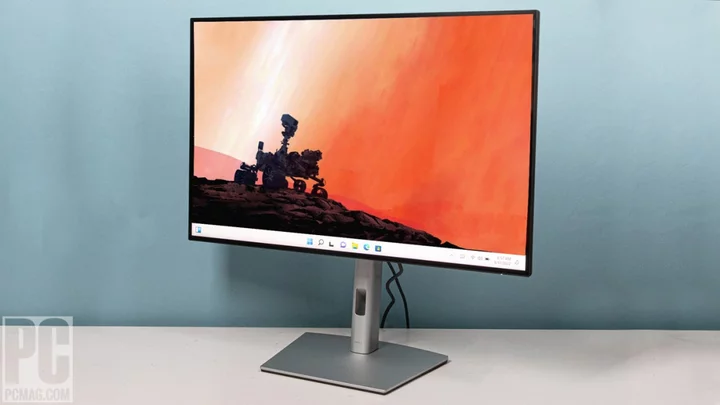Whether it's for gaming, office productivity, or creative work—or just to stream your favorite movies—a 4K monitor is a must-have upgrade for many PC users. But the 4K or ultra-high-definition (UHD) monitors on the market today are far from alike. Some offer speedy refresh rates to suit hardcore gamers. Others are designed for graphics pros, with precise color accuracy and support for wide color ranges. And some pack workflow-enhancing features that can make managing your desktop much easier.
Here's everything you need to know about the benefits (and possible pitfalls) of getting a new 4K display today. We've also ranked the 4K monitors that have made the cut according to our detailed testing. They're a great starter set for your search. They're broken out below, followed by a detailed guide to buying a 4K panel.
Ready to buy a 4K monitor? Let's define 4K first. The vast majority of 4K monitors have 16:9 aspect ratios with a native resolution of 3,840 by 2,160 pixels (horizontal by vertical). That's four times as many as a full HD or 1,920-by-1,080-pixel panel—and that's a lot of pixels. Some other resolutions with approximately 4,000 pixels across—most commonly 4,096 by 2,160—are also considered 4K. All these panels remain premium choices, but they're becoming increasingly common on desks at work, at home, and in gamers' frag dens.
(Credit: Molly Flores)But before we get too deep into details, we should help you answer a key question: Is a 4K monitor right for you in the first place? Depending on what you do most with your monitor, and where you'll place it, the extra money you'd pay versus a lower-resolution display may not be necessary.
To 4K or Not to 4K: That's the Gamer's Dilemma
For starters, if you want a really big 4K monitor solely for home-entertainment purposes that don't center on PC gaming, a 4K TV would likely be a cheaper option. That's because many 4K TV sets aren't beholden to the same standards that 4K monitors are, such as the need for boosted refresh rates (for gaming models), elite or specialized color accuracy (for content creators), or low input lag. (See our picks for the best TVs, now uniformly 4K models.)
Gaming at 4K is a demanding task that requires you to have relatively powerful hardware inside of your PC. In particular, you'll need a fast graphics card. If you're looking to run games with maxed-out graphics settings at 60fps or better you'll need one of the most expensive graphics cards money can buy. The immensely powerful Nvidia GeForce RTX 4090 is currently best suited for this task, though at $1,599 it's also prohibitively expensive.
Though you may not sail past 60fps on every game with maxed settings, you can competently run most if not all modern titles at that (or close to that) with several less-expensive GPUs. Nvidia has several upper-end GeForce RTX 40-series cards that are capable of gaming at 4K, and AMD's Radeon RX 7900 graphics cards are similarly capable. If you drop the graphics settings down, some older graphics cards, like many of those at the upper ends of the Nvidia GeForce RTX 30 series and AMD Radeon RX 6000 series, are also perfectly capable of providing a smooth 4K gaming experience in many games.
Gaming at 4K resolution isn't strictly about your hardware nowadays. A crop of software technologies (image sharpeners, upscalers, and supersamplers) from both AMD and Nvidia have hit the market recently. In a nutshell, these aim to allow PCs with midrange graphics cards or lesser integrated graphics (and gaming-console GPUs) to run at higher resolution while minimizing the performance hit and loss in visual quality.
Next Question: Can You See in 4K?
When shopping in the TV aisle, the answer as to whether you should opt for a 4K model today is almost always yes, because it's hard to find TVs with lower resolutions these days. It's not quite as simple with computer monitors. Getting serious about the question comes down to algebra and raises issues like pixel pitch, pixels per inch (ppi), and something called angular resolutions. Let's try to keep it simple, however.
A good example of the pixel-pitch problem arises with virtual reality (VR) headsets and an issue known as the screen door effect. In essence, the lower a display's maximum resolution and the closer you sit to it, the easier it is to see its individual pixels. In the case of VR headsets, this can make the image look as if it's seen through mesh, and it's why headset resolution has grown steadily—when something's that close to your eyes, you can more clearly see the difference.
The same considerations apply to monitors, just across a viewing distance measured in feet instead of inches. The tricky bit is that viewing distance isn't fixed but depends on the size and layout of your desk, your chair position, and so on. Whether you can make out the difference in image quality between a 4K display and, say, a 1440p panel (2,560 by 1,440 pixels) depends on not only the distance but your eyesight and the screen size. The last calculates out to a certain number of pixels per inch, in essence the screen's pixel density. You can see how it scales here at each common resolution.
(Credit: Wikimedia Commons)Luckily, we don't have to the math on our own. Workstation vendor Puget Systems has designed a helpful Google Sheet that will automatically help you figure the optimal display size and resolution for you depending on your personal visual acuity. All you have to do is plug in your target screen size and resolution, the distance between your eyes and the screen, and the specifics of your eyesight. You can then try different numbers and see how the output changes, helping you figure out if a certain size or distance makes more or less sense. (If you haven't been to the eye doctor lately and don't know your prescription strength, a few more calculations using some of the formulas on this page are all you need.)
Of course, less scientifically, you can look at 4K panels of various sizes in a local store to see if you can tell the difference between them and similarly sized 1440p or 1080p monitors. But ideally you'll want to observe the same screen image, scaled the same amount, to get a meaningful comparison, and that may not always be practical.
Still, to summarize: Before you buy a 4K monitor, make sure you'll actually be able to see the benefit of the increased pixel density given your seating setup. If you have 20/15 vision, sit three feet from the screen, and already own a 27-inch, 1440p display, you probably can't justify the cost of a 27-inch, 4K monitor. It all depends on how big your screen is, how close or how far away you'll sit, and your eyesight.
What 4K Screen Type Should You Buy?
Before you buy a new 4K monitor, you should know the pros and cons of the display technologies available. Most of the time, it's easy to find what type of panel a monitor has simply by looking at the manufacturer's spec sheet. Let's run through the most common kinds.
VERTICAL ALIGNMENT (VA). VA panels are some of the oldest in the game, but they're still around because despite better, newer display technologies, they "just work." VA screens offer some of the highest contrast ratios apart from OLED models (more about them in a moment), and better viewing angles and color reproduction than TN panels. However, VA is the slowest of all display technologies, offering the pokiest response times and highest input-lag numbers. That makes them a bad bet for gaming.
TWISTED NEMATIC (TN). TN displays, on the other hand, boast extremely fast pixel response times, averaging anywhere between 1 millisecond (ms) and 5ms, and they're relatively inexpensive to produce, making them ideal for gamers. The tradeoffs with TN? Uneven color reproduction, limited off-center viewing angles, and mediocre contrast ratios. That's a lot to give up for the sake of speed, which means that you'll typically see 4K TN panels only in gamer-centric monitors, and we're seeing fewer and fewer of them each year.
(Credit: Molly Flores)IN-PLANE SWITCHING (IPS). IPS panels are the most common of today's 4K displays. They tend to cost slightly more than VA or TN screens, but they offer the best all-around experience for most users: strong color reproduction, moderately quick response times, and the widest viewing angles of any display type except for OLED. The penalty? Prices anywhere from $50 to $300 higher than their non-IPS counterparts at a given screen size.
Since 2021, we've seen a host of monitors with tweaked panel types dubbed Fast IPS, Rapid IPS, Nano IPS, and IPS Black. The first three variants boost screens' gaming capabilities and overall color vividness, while the latter produces deep black tones and a contrast ratio that is much improved versus standard IPS panels.
ORGANIC LIGHT-EMITTING DIODE (OLED). Familiar from high-end HDTVs, OLED is the newest technology in computer monitors. Offering a theoretically infinite contrast ratio, gorgeous color for film and TV, and unbeatably dark black levels, OLED basically sounds like the ultimate display technology. The TVs we've seen look stupendous, and you'd think monitor manufacturers would be pumping out OLED models in droves.
Although 4K OLED panels have been all the rage for several years in the TV market (and are increasingly popular laptop displays), it's only recently, as the price of this technology has begun to come down, that OLED computer monitors have begun to make a splash. In the past year, we've seen OLED-based gaming, professional, and even portable monitors.
MINI LED. Finally, there's mini LED. Rather than edge-lighting an LCD-based panel with a ring of LEDs that sits around the display and lights the picture globally, this tech embeds hundreds or thousands of small LEDs behind the panel itself. This allows a lighting technique known as full-array local dimming (FALD), getting you close to OLED's infinite contrast at a lower cost.
What to Look for in a 4K Gaming Monitor
Though 4K displays are still far from the norm in the gaming monitor market, the top models are adopting rapid pixel-response times and blisteringly quick refresh rates. As the technologies in the panels (and the GPUs needed to power them properly) advance, which features should a potential 4K gamer look for? Let's lay them out.
INPUT LAG. In broad strokes, input lag is measured as the amount of time it takes for your monitor to display an external action. For example, if I click a button on my mouse, the input lag (measured in milliseconds) expresses how long it takes for something to happen on screen. Some of the best gaming monitors boast input lag below 2ms, though this is often slower with 4K displays because the number of pixels redrawn in each pass is greater at higher resolution.
(Credit: Molly Flores)REFRESH RATE. Gaming-monitor refresh rates have skyrocketed in recent years, especially at resolutions below 4K. While flat-panel displays seemed stuck at 60Hz for ages, it's easy to find 144Hz, 165Hz, or even 240Hz or 360Hz models in the esports arena, while a few recent monitors have reached the 500Hz mark.
Like so much else, it's more complicated with 4K. Due to the bandwidth limitations of the HDMI 2.0 and DisplayPort 1.4b interfaces and cables, early 4K monitors were limited to 60Hz. More recently, however, models have appeared that take advantage of HDMI 2.1, DisplayPort 2.0, and DisplayPort 2.1 to push that ceiling to 120Hz and beyond.
(Credit: Zlata Ivleva)RESPONSE TIME. Not to be confused with input lag, response time refers to the amount of time it takes for a pixel to change from black to white or from one shade of gray to another. In practical terms, you should expect a response time of under 20ms in even the slowest 4K monitors, and when shopping for a gaming panel it's better to aim for 5ms or lower to stay competitive in the long term.
ADAPTIVE-SYNC TECH. Nvidia's G-Sync and AMD's FreeSync and FreeSync2 are all flavors of what are known as adaptive sync technologies. Without getting too deep into the weeds, they're designed to prevent stuttering and screen tearing (screen draws with parts of the image misaligned). These maladies can occur on monitors—gaming-focused or otherwise—in fast-moving action scenes.
Adaptive sync aligns the refresh rate of the monitor with the frame-rate output of the video card on the fly, drawing a frame only when a full one is delivered rather than at a fixed rate. Though it's not essential for gamers who mostly play single-player, slow-paced titles, adaptive sync is great for anyone daring to take his or her skills into the online multiplayer arena in serious competition.
You need both a compatible monitor and a compatible graphics card to enjoy G-Sync or FreeSync (for the GPU, a late-model Nvidia GeForce or AMD Radeon RX card respectively). Note that Nvidia has designated a subset of monitors as G-Sync Compatible; these work with the adaptive-sync tech of its cards despite not having the specific, exclusive G-Sync-enabling circuitry of earlier G-Sync displays.
What to Look for in a 4K Monitor for Pro Graphics Work
With the monitor industry ramping up the move to 4K and consumers adding millions of such screens to their desks, digital content creators can hardly be expected to stick with 1080p. Professionals were among the first users to splurge on monitors with native 4K resolution, and these buyers continue to drive the market forward with 5K, 6K, and even 8K displays beginning to appear.
(Credit: Molly Flores)A 4K monitor is a nice addition to any amateur or professional creator's toolkit, though we should note that in terms of color reproduction or accuracy 4K screens have no inherent advantages over lower-resolution models. Instead, their main benefit is displaying higher detail in photography, 3D visual arts, or cinematography. Having more pixels gives you a greater level of accuracy, whether you're adding angel wings to an image of a fashion model, making vector art, mastering a movie, or doing anything that requires zooming in and retaining as much visual fidelity as possible.
Another benefit is extra workspace. Even if your ultimate output isn't in 4K, working on a 4K panel can let you see your content at full resolution while leaving screen space for control menus, color palettes, video timelines, and other creation tools. Of course, you could relegate that stuff to a second monitor, but a 4K panel can enable single-display workflows that were impossible or awkward before.
Color-gamut coverage is a key spec for many visual professionals. A number of elite 4K monitors cover 100% of the sRGB color gamut used online, as well as scoring nearly that high with the Adobe RGB and DCI-P3 gamuts used for photo and video imaging respectively.
What to Look for in a 4K Monitor for the Office
Keeping busy on a 4K monitor isn't much different from doing general work on a lower-resolution screen, but there's one key difference: effective screen space. Since a 4K monitor has four times as many pixels as a 1080p panel, this gives you in theory four times the elbow room to show application windows side by side.
The reason we say "in theory" is that it's almost impossible to make out the same text scaled 1:1 at 4K versus 1080p at the same screen size. This is why both Windows PCs and Macs come with a feature known as DPI (dots per inch) scaling. For example, when you switch your display resolution in Windows from 1080p to 4K, the operating system will by default scale your content to 150% of its standard DPI.
This increases the size of all rendered elements on screen by that percentage. At 150% scaling, it's more likely that you'd be able to fit two or three standard app windows side by side and still clearly read their text. With four windows in different screen quadrants? Not so likely.
(Credit: Molly Flores)To help simplify your workflow even more, some 4K monitors come with built-in features like an automatic window-sizing tool. (It sections off parts of your screen that Windows programs will resize to on their own.) These monitors can also accept video signals from multiple sources and display them side by side ("picture by picture") or inlaid in a larger window ("picture in picture"). This can be useful if, say, you're working on a PC but you need to test your changes on a separately connected Mac at the same time.
Connections, Adjustments, and HDR Support
Some specs are not as front-and-center as the display type or the refresh rate, but they'll affect how you work with your 4K display day to day.
The stand's adjustability might seem trivial, but it can affect your comfort depending on where and how you use your panel. A range of forward and backward screen tilt is pretty standard (usually listed in degrees), but you'll want to look for the ability to swivel the panel left and right on its stand or rotate it between landscape (horizontal) and portrait (vertical) modes. The last is less common and largely for serious photo editors, and is most likely to be found on 32-inch or smaller monitors.
Connectivity is another thing to check, though for most folks it comes down to either HDMI, DisplayPort, or USB-C if it supports DisplayPort over USB Alternate Mode. Most 4K monitors will have two or more of these inputs. Look for a match with your video source. A few panels support input via Thunderbolt, suitable for Macs and high-end Windows laptops.
(Credit: Molly Flores)One note: To get a 4K display running above a 60Hz refresh rate (mostly of interest to gamers or game developers), you'll need a graphics card capable of outputting its signal over a DisplayPort 1.4b, 2.0, or 2.1 cable; or an HDMI 2.1 cable.
Finally, there's the issue of HDR. High dynamic range is a color specification common in current 4K HDTVs, but it's also made inroads into monitors recently. (See our HDR primer for much more background.) Of course, you'll need content or media recorded in HDR or games that support the HDR spec in order to enjoy it. That said, if you have a monitor that also plugs into an Xbox One X, for example, that console will display all kinds of HDR content as a plug-and-play experience without issue.
So, What Is the Best 4K Monitor to Buy?
As you can see, upgrading to a 4K monitor entails a lot more than just a simple step up in resolution. But now you're ready to shop. We've tested a host of 4K monitors and gathered a selection of the very best in all the main usage classes: business monitors, gaming screens, and creative or visual professional panels. We broke out our favorites above and have included a detailed spec breakdown below; let's dig in.









